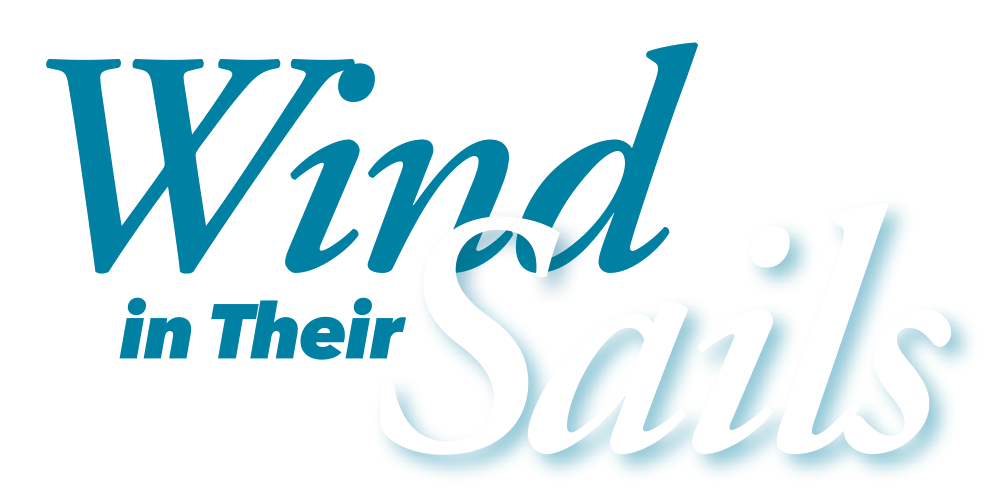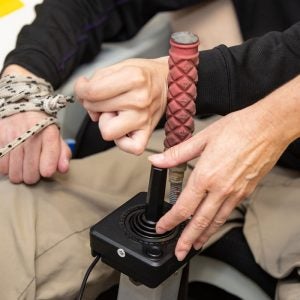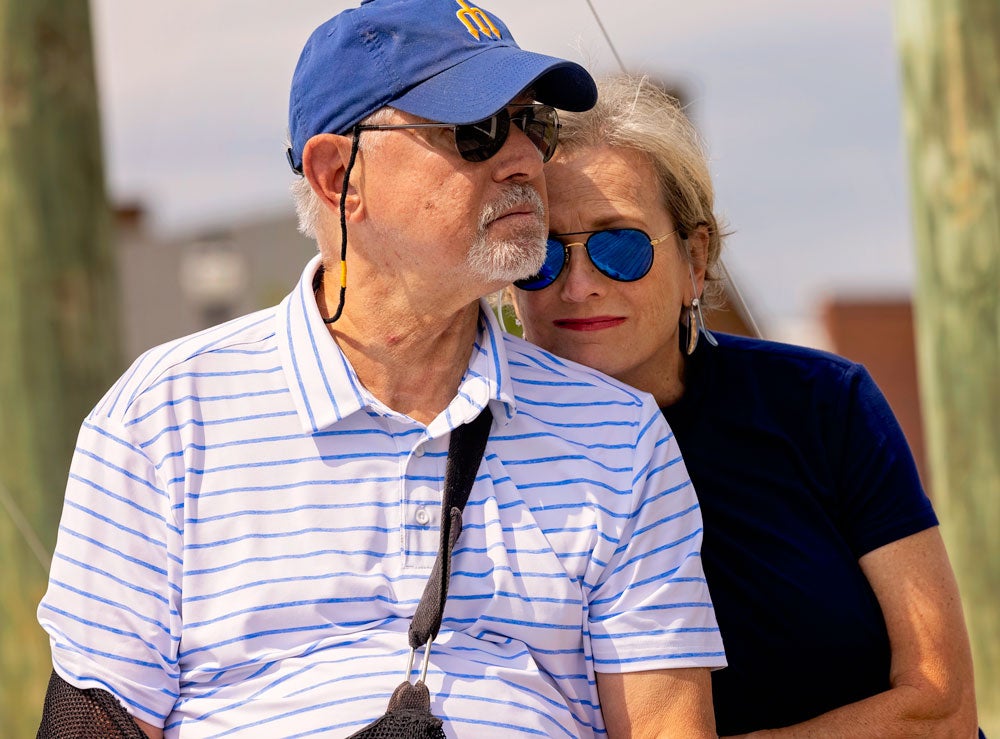Wind in Their Sails

A new partnership helps people with disabilities get on the water
It’s a picture-perfect afternoon on the Pamlico River as Brent Carpenter wheels himself down the ramp onto a floating dock where a sailboat waits, tugging gently at its lines in the light breeze.
Carpenter, 39, lost most of the use of his arms and legs after breaking his neck diving into a pool 15 years ago. A wakeboarding and watersports enthusiast before the accident, he is now a participant in an adaptive sailing program led by Cari Autry of East Carolina University’s Department of Recreation Sciences.


From left, Stephen Anderson and Cari Autry work with Brent Carpenter on ECU’s sailing simulator.

We’re teaching people with physical disabilities how to sail and then measuring quality of life. And then we’re also looking at some other physical benefits.
– Cari Autry, Department of Recreation Sciences
Participants start learning to sail in the lab using a virtual reality sailing simulator nicknamed Bonny after the pirate Anne Bonny. The simulator is one of only three in the country and is in Autry’s sailing simulation lab on campus.
“We’re teaching people with physical disabilities how to sail and then measuring quality of life,” Autry says. “And then we’re also looking at some other physical benefits” such as strength, balance and the benefits of sailing as a nature-based activity for people with physical disabilities.
Carpenter waits patiently as Autry, along with Stephen Anderson, adjunct professor and certified sailing instructor, and graduate student Jennifer Savage rig a hoist that will lower him from the dock into the sailboat, a Martin 16, which is specially designed with adaptive features to allow people with physical disabilities to sail.
Autry and Anderson, who brought the simulator with them when they came to ECU from Miami in 2018, didn’t expect to be standing on the dock sending one of the virtual reality sailing simulation participants out on the water in an actual sailboat.
“The dream was to be able to have something on the water,” Autry says, but she could never have imagined the partnership that brought it about.
A connection at ECU put Autry in touch with Kevin Clancy and David Norwood of Little Washington Sailing School in 2019. The sailing school operates from a dock on the waterfront in Washington just a half-hour’s drive from ECU, and Norwood knew Jon and Robin Kenney, the owners of the Martin 16.
Jon, a lifelong sailor, had a stroke in 2008. “It was about two years of really intense rehab just to get to where he could walk again,” Robin says. Eventually he was able to participate in therapeutic horseback riding, and then he found out about the Martin 16.
The 16-foot boat is designed with several features that make it ideal for disabled sailors. It is very stable, with a 300-pound bulb on the keel that makes it nearly impossible to capsize, and foam flotation in the hull makes it unsinkable, even when flooded. The steering and the sails can all be controlled from the helm seat, and a second seat behind the helmsperson allows an instructor or assistant to help as necessary.
After sailing a Martin 16 in a regatta in San Diego, Jon fell in love with the boat, Robin says. They ordered one and had it shipped to Bend, Oregon, where they lived at the time. Robin — not a sailor, she points out — is learning how to sail the boat with Jon, and they brought it along when they moved to Chocowinity, just across the river from Washington.
“It gives him the freedom that he likes and control; he can manage things,” she says. “And for us it’s something to do together.”
But they always wanted to share the boat with others, she says, for it to be a community benefit. So when they heard from Norwood and then talked with Autry and Anderson about the adaptive sailing program at ECU, it seemed like a natural fit.
The Kenneys were happy to allow the use of the boat, the sailing school installed a ramp with railings to provide wheelchair access to the dock, and Autry got a grant for a hoist to lift people into the boat.
“The stars lined up,” Autry says. “All of these people are just wonderful. … It’s a perfect partnership.”
While Autry runs the lab and leads the program, Anderson serves as the main instructor and covers a standard U.S. Sailing curriculum with the participants. They learn terminology and techniques in the simulator, and now they can apply what they’ve learned on the water.
“Today we’re going to sail to windward and round a mark; we’re going to take that mark to port,” he says. “Then we’re going to sail downwind to that leeward mark. We’ll do that a couple of times and then go around the other way, take it to starboard.”

Jon and Robin Kenney let ECU use their Martin 16 sailboat, equipped for use by people with disabilities.
The terminology was all new to Carpenter when he started the program, he says. Ropes are lines and sheets; left and right are port and starboard. He has just enough use of his arms to steer the boat by wedging the backs of his hands on either side of a vertical steering mechanism called a whipstaff.
“It’s a lot more challenging,” he says. “Somebody like me, I’ve always been into sports and always been up for a challenge. So it’s just a complete game changer. I was raised on the water, so anytime you’re out on the water, if you see me, you’ll probably see me smiling.”
For Little Washington Sailing School, Clancy says it’s rewarding to get people out sailing.
“With our mission at the sailing school being to get kids on the water, we’ve expanded that the last few years with an adult program and now the adaptive program,” he says. “We’re just trying to get people on the water, and the idea that this sailing simulator … would relocate to our area, to be able to use our docks and make this happen, it’s just perfect.”
Autry’s research has shown benefits in quality of life and physical aspects using the sailing simulator, and she’s thrilled that it has worked out to get on the water.
“Our participants don’t know anything about sailing (when they start),” she says. “They may have seen a sailboat, but they don’t think that would be anything for them. So it’s definitely eye opening, a confidence builder. They’re learning something new, something that they never thought they could be a part of.
“And now we’re out on the water. Because of the constraints on people with physical disabilities, they often don’t have as much access to the outdoors.”
Jon Kenney, whose speech has come a long way since his stroke, sums it all up with an expansive gesture at the boat, the people on the dock and the harbor.
“This,” he says, “is very, very good.”